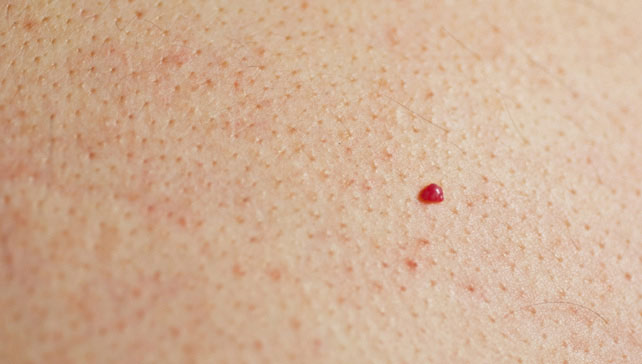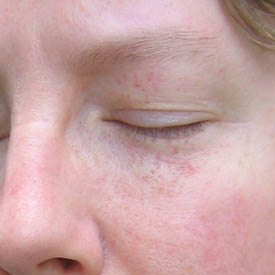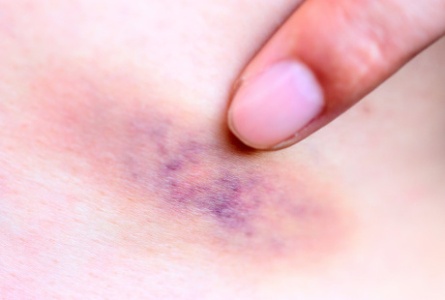New Health Advisor
Petechiae with a fever in children can be a sign of a serious infection like meningococcal disease. Have a doctor check these symptoms right away.
Petechiae
Petechiae are tiny red, flat spots that appear on your skin. They’re caused by bleeding. They sometimes appear in clusters and may look like a rash. If you have tiny red, purple, or brown spots on your skin, they could be petechiae. They’re not a disease, but a symptom. A number of things can cause them to happen, from a severe coughing fit to an infection.
Often, petechiae are nothing to worry about. Still, it’s always a good idea to check with your doctor if you’re not sure where these spots came from. Some conditions that cause petechiae are very serious.
Petechiae are more common in kids. If your child has this rash, especially with a fever, take them to a pediatrician right away.
Causes of Petechiae
Petechiae are a sign of blood leaking from capillaries under your skin. Capillaries are the tiniest blood vessels that connect arteries to veins. They help move oxygen and nutrients from your bloodstream to your organs and tissues. They also carry waste away from your organs and tissues.
Leaking in the capillaries could be due to an illness or a medicine you take. Petechiae may also form on your face, neck, or chest if you strain intensely or for a long time when you do things like:
- Cough hard
- Vomit
- Give birth
- Lift heavy weights
Many infections with bacteria, viruses, or fungi can cause these spots, too, including:
- Viral infections like cytomegalovirus (CMV), endocarditis, mononucleosis, and the flu
- Bacterial infections such as meningitis, Rocky Mountain spotted fever, scarlet fever, and strep throat
- Henoch-Schonlein purpura, a disease that causes inflammation in the small blood vessels
- Sepsis , a serious, body-wide response to an infection
- Viral hemorrhagic fevers like dengue, Ebola, and yellow fever
Blood and immune disorders can also cause petechiae, such as:
- Hemolytic-uremic syndrome (HUS), a group of blood disorders
- Idiopathic thrombocytopenic purpura (ITP), an immune disorder that affects blood clotting
- Leukemia , a type of blood cancer
- Thrombocytopenia , low levels of platelets that help your blood clot
- Vasculitis, or blood vessel inflammation
A lack of vitamin C (scurvy) or vitamin K in your diet can also lead to petechiae.
Reactions to certain medicines can cause these spots, too. Petechiae may be a side effect of drugs like:
- Penicillin , an antibiotic
- Quinine (Qualaquin), a malaria drug
- Phenytoin and valproic acid, which are seizure medications
- Blood thinners (warfarin/heparin)
- Antidepressants (desipramine)
- NSAIDs (naproxen/indomethacin)
- Heart rhythm drugs (atropine)
- Sedatives (chloral hydrate)
What Does Petechiae Look Like?
Petechiae are flat and look like pinpoint-sized red, brown, or purple dots. Clumps of them on your skin look like a rash. But unlike many rashes, when you press on the spots they don’t turn white. And if the spots are larger and red or purple, you may have another type of bleeding problem called purpura.
Petechiae can form just about anywhere on your body, even your eyelids or inside your mouth.
Petechiae Diagnosis
Petechiae with a fever in children can be a sign of a serious infection like meningococcal disease. Have a doctor check these symptoms right away.
The doctor will examine your child, look at the rash, and ask about their symptoms and recent illnesses. Blood and urine tests may help pinpoint the cause of the spots.
Other serious illnesses can also cause petechiae in your child. If your child has the spots, look out for these other symptoms:
- Trouble breathing: If your child has shortness of breath or trouble breathing along with petechiae, it can be a sign of a serious condition called endocarditis. Endocarditis means there’s an infection in the lining of the inner chambers of the heart and the valves.
- Confusion: Petechiae — along with confusion — could indicate that your child has Rocky Mountain spotted fever, an infection caused by the bite of a tick.
- Change in consciousness: Some infections caused by viruses, known as viral hemorrhagic fevers, can cause changes in consciousness as well as show signs of petechiae. These diseases include dengue, yellow fever, lassa, marburg, and ebola. They’re found in tropical countries and cases in the U.S. are usually from people who traveled to these areas.
Call their doctor right away if you have any concerns.
Petechiae Treatment and Home Remedies
The rash itself doesn’t need treatment. If it’s caused by a virus, the spots should clear up as soon as the infection goes away.
If you think your petechiae might have been caused by a minor incident, like strenuous coughing, vomiting, or weightlifting, you may be able to take care of it at home by doing the following;
- Resting
- Taking extra fluids to prevent dehydration
However, since petechiae may be the result of a serious underlying condition it is best to consult your doctor when these spots appear.
If you have a bacterial infection, you may need to take antibiotics. Make sure you take the full dose of medicine, even if you start to feel better.
More serious diseases such as meningococcal infections, blood disorders, or cancer may need treatment in a hospital. Your doctor may suggest you see a specialist in infections, blood diseases (hematologist), or cancer (oncologist) to oversee your care.
Petechiae Prevention
The only way to avoid getting petechiae is to try to prevent the various conditions that can cause it. Take good care of yourself:
- Practice good hygiene such as washing your hands, brushing your teeth, and sanitizing your living environment. Don’t share personal items (straws, utensils, tooth brushes etc).
- Avoid procedures that can lead to skin infections like getting tattoos and piercings. Pay close attention to your health and see your doctor about fevers and infections that don’t resolve quickly.
- Eat fruits and vegetables or take supplements to ensure you get enough vitamins in your diet.
- Get vaccinated (immunized) to prevent certain types of bacterial meningitis.
- Avoid mosquitoes and ticks by wearing long pants and long-sleeve shirts if you’re in an affected area and use insect repellents containing DEET.
Show Sources
DermNet NZ: “Cutaneous adverse effects of anticonvulsant drugs.”
Government of Western Australia Child and Adolescent Health Service: “Petechiae.”
Mayo Clinic: “Petechiae.”
National Center for Biotechnology Information: “Petechiae.”
Pediatric Annals: “Petechiae and Purpura: The Ominous and the Not-So-Obvious?”
The Franklin Institute: “Blood Vessels.”
MedlinePlus: “Naproxen: What Side Effects Can This Medication Cause,” “Indomethacin: What Side Effects Can This Medication Cause.”
FDA.gov Label: “Atropine Injection, 2 mg,” “Adverse Reactions,” “Dermatologic.”
Mount Sinai: “Bleeding Into the Skin.”
Saudi Dental Journal: “Oral manifestations of thrombocytopenia.”
Why Do I Have Pinpoint Red Dots on Skin?
The appearance of red dots on the skin can be very alarming and can be due to a variety of reasons. Some reasons are rather harmless whilst some reasons are fairly serious and require medical attention. These dots may vary in appearance and can be due to allergies, inflammation or infections. When the cause of the red dots is broken blood vessels under the skin, it is medically termed petechia. Petechia is easily distinguishable from erythema (redness of the skin) by applying pressure onto the area. If there blanching with pressure, then it is most likely erythema.
Possible Causes of Pinpoint Red Dots on Skin
1. Cherry Angiomas

The condition is also known as hemangioma. These red dots are harmless and can be numerous on some people. They may vary in color from bright red to dark pink. The sizes also differ and they do not disappear with time.
2. Straining for a Long Period

Childbirth, coughing, crying, vomiting or even weightlifting can cause small petechia in areas of the face, neck and chest. Some babies are born with petechia on the head and neck, especially larger babies. Breech babies sometimes present with petechia on their buttocks. This is normal and can be attributed to the birthing process. These pinpoint red dots on skin usually resolve spontaneously and are nothing to worry about.
4. Skin Bruising or Extravasation

This occurs when red blood cells leak out of damaged capillaries. It is easy to inflict this trauma onto your skin-sometimes all it takes is a little pressure from your nail to your skin to cause it. These dots disappear by themselves after some time.
5. Viral, Fungal and Bacterial Infections
Petechia is sometimes the result of infections like strep throat, scarlet fever, mononucleosis, cytomegalovirus (CMV) and endocarditis. These should clear up once the infection has been cleared.
6. Medicines
Some medicines can cause petechia as a side effect. Anticoagulants (heparin and warfarin), antibiotics (penicillin), quinine, atropine are some drugs that cause pinpoint red dots on skin.
7. Allergies
Allergens like certain foods (e.g. fish and nuts), insect bites or certain plants can initiate an immune response in some people. The allergy could present with small red dots on the skin, which can be itchy or not. Depending upon the severity of the allergy, you may require medical attention.
8. Skin Aging
Older people often exhibit red dots on their lower extremities, which is caused by scratching the area and damage to the capillaries.
9. Atopic Dermatitis
It is an inflammatory reaction of the skin. It may be caused by three factors: genetics, environment and an impaired immune response to certain allergens. It can present as pinpoint red dots on skin which can be itchy or not.
10. Thrombocytopenia
This condition occurs when you have a low blood platelet count. These platelets are necessary for clotting of blood in the case of bleeding. Having thrombocytopenia can be a result of another disease like leukaemia or an immune system disorder. Common symptoms are bruising easily, petechia, bleeding gums, etc. This is a serious condition and requires medical attention.
Other People’s Experiences with Pinpoint Red Dots on Skin
I am a mother on my third pregnancy and have noticed pinpoint red dots on my skin, particularly my upper chest and hands. My doctor has said they are harmless petechia due to the increased blood volume in my body. I am worried because I have not experienced this in my previous two pregnancies.
My elderly mother has these red dots that have appeared on her skin. We were told they could be due to her Celiac disease, which has gotten worse recently.
I have developed several pinpoint red dots on skin, literally overnight. My doctor gave me a very cursory exam and brushed me off saying they were not serious. I have many other symptoms and more dots keep appearing.
I am a 25-year-old fair-skinned male. I have cherry angiomas, but recently the number seems to have increased on my trunk. My dermatologist said not to be concerned because they appear with age. I have noticed them on my father as well. I’m still worried about these cherry angiomas.
When to See Your Doctor
- Unexplained bruising that will not resolve on its own.
- A sudden indication of bleeding into the skin.
- If the red dots are accompanied by:
- Stiff neck
- Swelling of the face, oral cavity, throat
- Difficulty breathing
- Increased heart rate
- High fever
- Severe headache
How to Prevent Pinpoint Red Dots on Skin
- Avoid excessive sun exposure to protect the skin from aging prematurely.
- Take care and avoid trauma to the skin. Pay close attention when you’re shaving and waxing. Treat any injury to the skin appropriately.
- If you suspect your medical treatment is causing the red dots on your skin, consult your doctor who will advise you.






